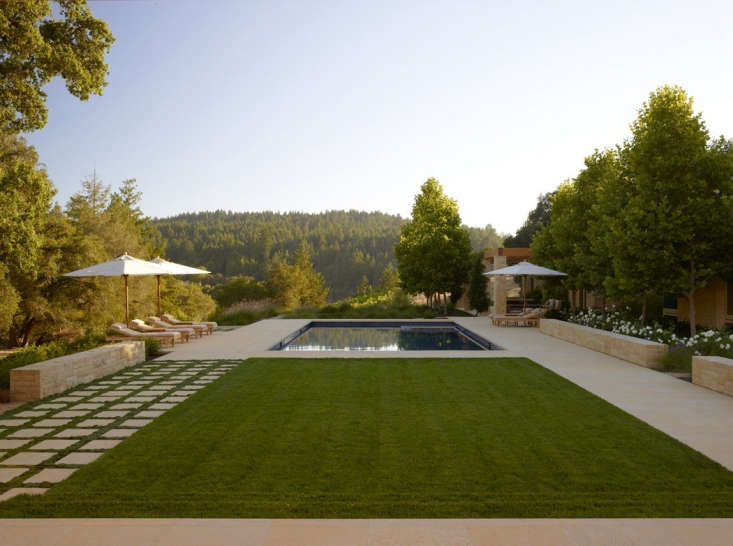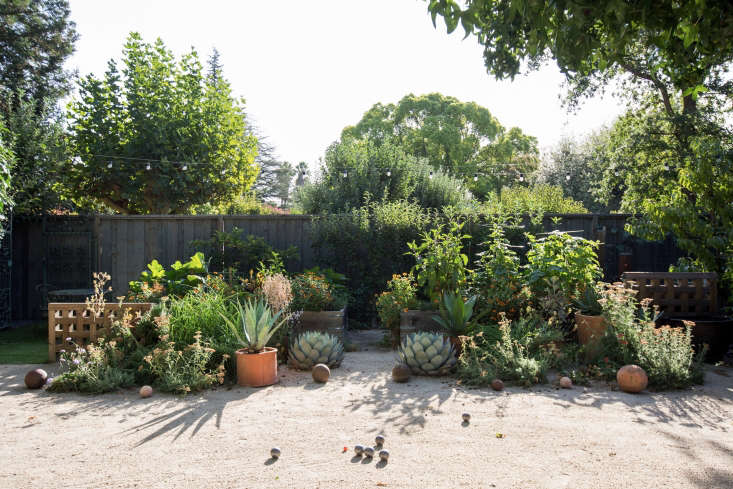The wildfires that have ravaged parts of this country are making us all more aware of this real or potential threat. You’re at higher risk if you live close to wildlands, or in an area with low rainfall where dry vegetation can spread flames in an instant.
What can you do to keep your family, property, and home safe from fire damage? The type of plants in your garden, the design of your landscape, and how you maintain it can all make a big difference. For solutions, we consulted with Michele Steinberg, Wildfire Division Manager at the National Fire Protection Association. According to Steinberg, “There are easy techniques people can use with their landscaping and gardens to resist fire and protect their homes.”
Here are 10 tips for designing a fire-smart landscape:
1. Prune trees so the branches don’t touch or overhang the house.

“Even if you have a good roof and siding, you could have an issue if you’ve got a lot of flammable vegetation up against the house,” says Steinberg. Ideally, trees should be placed at least 10 feet away from structures, and you should remove “ladder fuels” by pruning the branches up at least six feet to reduce the chance of the trees catching fire from flames traveling along the ground.
2. Plant shrubs well away from the house.

You don’t want branches touching the façade. “The area out to about five feet is a critical zone,” Michele says. “You could have some low-growing plants there, especially if they’re ones that have a lot of moisture.”
3. Dispose of debris.

Clear away any leaves and branches left by pruning, and rake up and dispose of leaves and other debris that has accumulated near your house, especially within 10 feet. Don’t let dry grass, leaves, pine needles, and other debris collect under your deck or porch.
Of course, it’s also wise to keep the rain gutters on your house free of combustible debris, as well as any flat surfaces such as roofs, porches, and carports.
4. Choose fire-resistant plants.

Plants are less likely to ignite if they have moist, supple leaves and a low amount of sap, resin, oil, or wax. “Because plants vary so much around the country, we don’t list which ones are more or less flammable,” says Steinberg. Instead, the NFPA recommends that homeowners ask the nearest Co-op Extension (an educational service offered by the U.S. Department of Agriculture) for lists of fire-wise plants in their region.
“Or you can research it by Googling ‘fire-wise plants’ or ‘fire-wise landscaping’,” Steinberg adds.
5. Keep your lawn mowed and well irrigated.

“Grass that’s kept watered and mowed is much less likely to catch fire from embers or small flames running along the surface of the ground, burning whatever they can burn,” Steinberg says.
6. Keep your plants healthy.

“Plants in good condition won’t present nearly as much risk as dead or dying plants that are throwing off a lot of leaves or debris,” says Steinberg. “Maintain a regular irrigation schedule and so shrubs don’t get overgrown or dry—keep them well pruned without dead leaves and branches.” If water use is restricted in your area, consider xeriscaping.
7. Avoid flammable mulches.

“Parts of the country use pine needles for mulch, and while these don’t carry fire for very long, they do burn well and have caused a lot of problems,” says Steinberg. “Even bark mulch will ignite, so it can be a big hazard when it’s piled up against a house’s wood shingles or under a deck.” Instead of organic materials, use gravel, pebbles, or rock for mulching, especially in that vulnerable area up against the house.
8. Replace wooden decks, fences, and boardwalks with nonflammable materials.
Consider putting in a stone or concrete patio instead of a deck, and perhaps metal fencing in place of wood.

“Hardscaping is a good way to break up the continuity of vegetative fuels, such as grasses, plants, and shrubs,” says Steinberg. “Think about little flames creeping across the grass: when they hit a cement walkway they’re going to stop, as there’s nothing left to burn.” Fire-resistant materials are also a good choice for patio furniture, swing sets, and the like.
9. Be careful with your fire pit.

“There’s no one season for fire risk across the country,” Steinberg says. “It may seem unlikely, but we get a lot of brush fires in Massachusetts in April. People will say, ‘It’s a nice warm spring day, let’s light up the fire pit in the backyard.’ They’re not aware that wind can pick up embers and carry them away, and in dry conditions that can lead to fire.” Steinberg’s advice: Use a fire pit with extreme caution, and not before checking with the National Weather Service to see if a fire warning has been issued for your area.
10. Use common sense.

Do we even need to say this? Make sure your hoses are in good shape for use in an emergency. Store firewood well away from the house. In fire season, refuel your lawn mower far from flammable materials. And don’t keep propane tanks near the house.
For more information about fire-safe gardening, go to Firewise USA.
N.B.: This post is an update; it was first published in 2020.
- Gravel 101: A Design Guide.
- 10 Genius Garden Hacks with Poured Concrete.
- 10 Easy Pieces: Concrete Outdoor Furniture.












Have a Question or Comment About This Post?
Join the conversation (2)